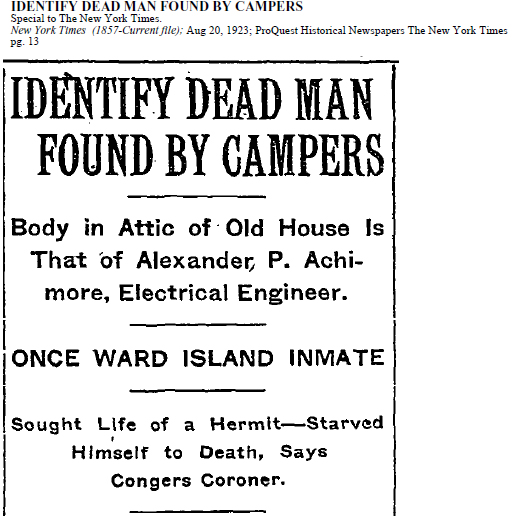In June 1923, the Chelsea Presbyterian Church organized a summer camp at Rockland Lake, a resort town in the summer and a place of commercial ice harvesting in the winter. Two families who arrived first set up camp near an abandoned house along the west side of the lake, in a secluded location away from the village of Rockland Lake. The campers stored food in the house and sought shelter there in bad weather; otherwise they kept to their outdoor camp.
Shortly after arrival, the campers heard “spooky” sounds that emanated from within the house – boards creaking, the sounds of someone going up and down stairs. A man in the camp ground went inside the “haunted house” to investigate with a flashlight. He did not find the source of the noises, but he was too scared to go upstairs to investigate further.
The next day, the noises returned, and again the lower floors of the house were searched, but again the the half-story attic was neglected. A supply of food was noticed missing, and a young boy of the group complained loudly that two dollars worth of food had “taken wings.”

That night, a loud noise was heard, and the next morning the group again investigated. This time, a check for two dollars was found, to pay for what had been taken. The check was signed by Alexander P. Archimore. The check was cashed at a Nyack bank which determined the check to be good. Later, a letter was received by the campers from a man who said he was the brother-in-law of Alexander Archimore, who has been missing. Archimore had previously been missing and was also located that first time by means of a cashed check. The campers responded that they did not know the man and discarded the letter, and they soon left the camp site.

Another group took over the camp site, which they soon vacated, not because of spooky noises but, due to stagnant odors thought to be caused by dead rats in the walls of the house. The original party returned to this site on August 19 and finally conducted a thorough search of the “house of queer sounds.” Looking through an opening in the second floor ceiling to the half-story attic, one of the campers, named Charles Murdock, climbed the opening and cast his flashlight, “which fell upon the face of (a) dead man.”

The campers called authorities to investigate further. A letter in the dead man’s pocket was addressed to Alexander P. Archimore, in the care of Mrs. Adams, 359 Prospect Place, Brooklyn, NY. The story roused considerable attention among “hundreds of persons” who helped to conclusively identify the man and locate his family.
The steps up to the half-story attic
He indeed was Alexander P. Archimore. For ten years Archimore was an electrical engineer, specializing in tower work, for the Western Union Telegraph Company. He left Western Union around 1920 to take a job with a company in New Hampshire. It was said that he worked so hard that he strained himself mentally. Archimore’s friends thought he had “become insane.” He submitted to testing at Bellevue Hospital in October 1921 and was determined to be “mentally unbalanced.” He was sent to Ward’s Island and pronounced cured in the summer of 1922. His wife then moved to Boston with their seven year old son, and Archimore moved in with his sister, Mrs. Adams, in Brooklyn.
After his breakdown, Archimore sought to live apart from the world, and he found refuge at Rockland Lake, where the Palisades Interstate Park Commission leased old houses, bungalows, and camp sites in the summer. In particular Archimore chose a stone house with chipped paint that presented a “rundown, grotesque appearance”, fronted by tall trees and a large lawn. Archimore was not known known by other campers so it was believed that he foraged for food at night, until the Chelsea Presbyterian Church group arrived and kept their provisions in his new house. Authorities believed Archimore decided to starve himself to death between July 4 and July 10, 1923.

_____________________________
The photographs here are not from the actual house in this account. The images present two different abandoned houses in Rockland County.
Because the articles are available for purchase on the New York Times, it is not appropriate to reprint the entire pieces here. They can be purchased at the following links.
“Trace Weird Noises; Find Man Long Dead.” – August 19, 1923.
“Identify Dead Man Found By Campers.” – August 23, 29123.
BONUS:
The Runaway Horse and the Shattered Hearse
On October 20, 1899, a “mysterious and terrific explosion occurred at the works of the Rockland Lake Trap Rock Company.” The explosion killed four men, including assistant foreman Hugh McCue, and three Hungarians whose names were not known at the time of the article. Four others were badly injured and were not expected to survive.
Their funerals were held three days later. En route to the cemetery, a team of horses carrying one of the hearses became frightened and ran away and overturned the hearse, which shattered to pieces. The driver was hurt. I suppose at some point that all the pieces were collected, and the man was finally laid to rest in peace.

_____________________________________________________
This October I aim to post a series of entries in the spirit of this being the month of Halloween and this being the Hudson Valley, home of the Legends of Sleepy Hollow and the Catskills.
During the course of researching Hudson Valley Ruins, Tom Rinaldi and I found numerous interesting articles that did not directly tie into the topics we wrote of in our book, but nonetheless are illuminating vignettes of Hudson Valley industries, institutions, and culture. We saved those articles in hopes of finding another outlet. A few of them will inspire a handful of blog entries over the next month. Some entries will be more brief and not as thoroughly illustrated as this piece. Some entries will cover stories dark and disturbing. I think the last post is going to the best entry – I look forward to writing that one. Thanks for reading along.
